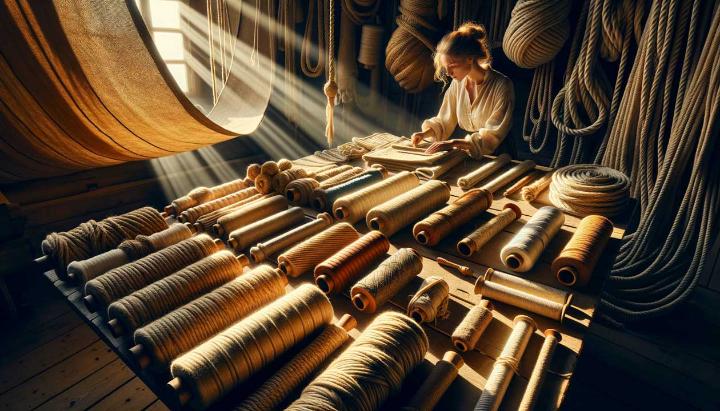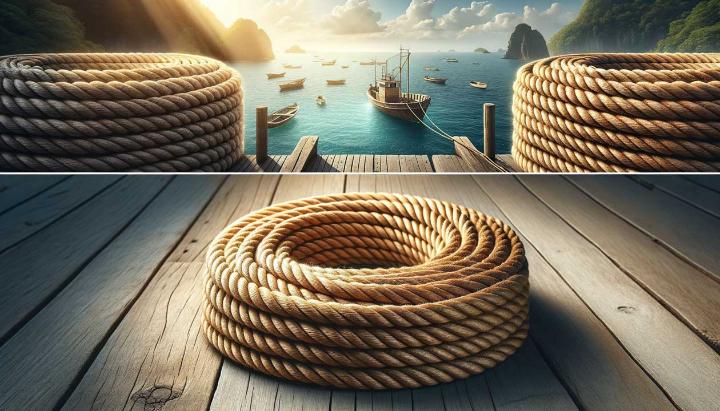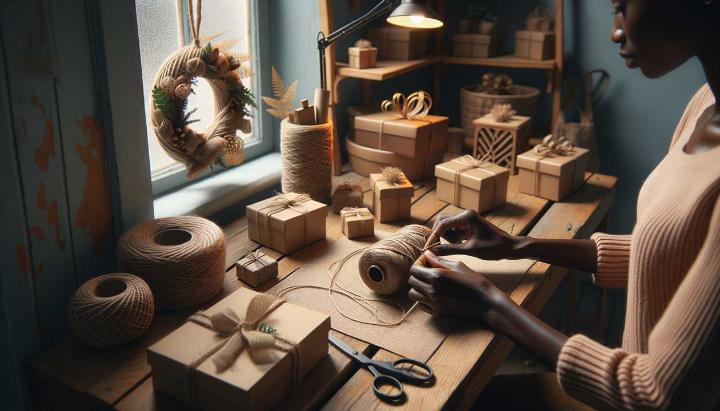Have you ever considered the remarkable versatility of natural fiber rope? In a world dominated by synthetic materials, the humble 1 inch natural fiber rope stands out as a testament to nature's ingenuity. From the decks of sailing ships to the heart of your garden, this eco-friendly cordage is experiencing a renaissance, and for good reason.
Imagine a material that's not only incredibly strong but also biodegradable, sustainable, and rich in tactile appeal. That's the magic of natural fiber rope. As we delve into the world of 1 inch natural fiber rope, you'll discover why it's becoming the go-to choice for savvy professionals and DIY enthusiasts alike.
In this post, we'll unravel the mysteries of natural fiber cord, exploring its myriad benefits and applications. Whether you're a boating enthusiast, a green thumb, or an industrial professional, you'll find that this versatile material offers solutions you might never have imagined. Join us as we explore how this time-honoured product is making waves in today's eco-conscious world, proving that sometimes, the best innovations are the ones nature provides.
Understanding Natural Fiber Rope: Composition and Properties
Have you ever run your fingers along a natural fiber rope, feeling its unique texture and strength? As someone who's spent years working with various types of cordage, I can tell you there's something special about natural fiber ropes that synthetic alternatives just can't match.
Natural fiber ropes are made from organic materials derived from plants, such as sisal, cotton, jute, manila, and hemp. These fibers are twisted or braided together to create strong, durable ropes that have been used for centuries in various applications.

Common Types of Natural Fiber Ropes
Each type of natural fiber rope has its own unique properties and best-suited applications:
- Sisal rope: Known for its strength and resistance to stretching, sisal is often used in marine and agricultural settings.
- Cotton rope: Soft and flexible, cotton ropes are perfect for decorative purposes and gentle on the skin.
- Jute rope: Biodegradable and eco-friendly, jute is commonly used in gardening and crafts.
- Manila rope: Made from abaca fiber, manila rope is incredibly strong and resistant to saltwater, making it ideal for marine use.
- Hemp rope: Durable and resistant to UV damage, hemp ropes are versatile and widely used in various industries.
Advantages and Disadvantages of Natural vs Synthetic Ropes
When comparing natural fiber ropes to their synthetic counterparts, there are several factors to consider:
Did you know?
Natural fiber ropes are biodegradable and environmentally friendly!
Natural fiber ropes have a unique charm and offer several advantages:
- Eco-friendly: They're biodegradable and sustainable, reducing environmental impact.
- Grip and handling: Natural fibers provide excellent grip, even when wet.
- Aesthetics: They have a rustic, traditional appearance that's perfect for certain applications.
However, they do have some limitations:
- Durability concerns: Natural ropes can be susceptible to rotting, degradation, and mildew, especially in damp conditions.
- Strength variability: The strength of natural fibers can vary more than synthetic materials.
- Maintenance needs: They often require more care and maintenance than synthetic ropes.
On the other hand, synthetic ropes offer:
- Consistent strength: They provide more uniform strength and performance.
- Weather resistance: Synthetic ropes are generally more resistant to UV damage and moisture.
- Low maintenance: They require less care and have a longer lifespan in certain conditions.
When choosing between natural and synthetic ropes, consider your specific needs. For instance, if you're looking for an eco-friendly option for your garden or a decorative rope for your home, natural fiber might be the way to go. But for heavy-duty marine applications or outdoor use in harsh conditions, a synthetic rope could be more suitable.
Remember, there's no one-size-fits-all solution. The best rope for you depends on your unique requirements, the environment it'll be used in, and the level of maintenance you're willing to undertake. So, next time you're in need of a rope, take a moment to consider the natural fiber options – you might be surprised by how well they suit your needs!
Benefits of 1-Inch Natural Fiber Rope
As someone who's worked with various types of ropes for years, I can confidently say that 1-inch natural fiber rope offers a unique blend of versatility, strength, and eco-friendliness. Let's dive into the remarkable benefits of this robust and sustainable cordage option.
Versatility and Wide Range of Applications
One of the most striking features of 1-inch natural fiber rope is its incredible versatility. I've seen it used in countless applications, from marine environments to creative DIY projects. Here are just a few ways this versatile rope shines:
- Marine and boating: Perfect for dock lines, anchor ropes, and general nautical use due to its strength and resistance to saltwater.
- Landscaping and gardening: Ideal for tree supports, rustic fencing, and creating charming garden features.
- Crafts and decor: A favourite among artisans for creating unique home decor items, from hanging planters to statement lighting fixtures.
- Industrial applications: Widely used in construction and warehousing for its load-bearing capacity and durability.
Durability and Strength
When it comes to durability and strength, 1-inch natural fiber rope, especially manila rope, is hard to beat. Made from the resilient abaca fiber, manila rope boasts impressive tensile strength. In fact, a 1-inch manila rope can support loads of up to 1,800 kg, making it suitable for heavy-duty applications.
Did you know?
1-inch natural fiber rope is approximately 25.4 mm in diameter, offering an ideal balance between strength and manageability.
Unlike synthetic ropes, natural fiber ropes like manila have a unique ability to absorb shock loads, reducing the risk of sudden breaks under stress. This characteristic makes them particularly valuable in marine applications where sudden strains are common.
Eco-friendliness and Sustainability
In today's environmentally conscious world, the eco-friendly nature of natural fiber ropes is a significant advantage. As a biodegradable product, these ropes don't contribute to plastic pollution, a growing concern with synthetic alternatives.
Moreover, the production of natural fiber ropes, such as manila hemp rope, has a lower carbon footprint compared to synthetic rope manufacturing. By choosing 1-inch natural fiber rope, you're not just selecting a high-quality product; you're also making an environmentally responsible choice.

Whether you're a boating enthusiast, a DIY decorator, or an industrial professional, 1-inch natural fiber rope offers a perfect blend of functionality, durability, and environmental consciousness. Its versatility, strength, and eco-friendly nature make it a superior choice for a wide range of applications. So why not give it a try in your next project? You might be surprised by how well it meets your needs while also being kind to our planet.
Applications of 1 Inch Natural Fiber Rope
As a seasoned rope enthusiast, I've had the pleasure of working with 1 inch natural fiber rope in various settings. Its versatility never ceases to amaze me. From the salty air of marinas to the earthy scents of gardens, this robust cordage finds its place in countless applications. Let's explore some of the most common and innovative uses for this eco-friendly wonder.
Common Uses for Manila Rope
Manila rope, derived from the resilient abaca plant, stands out as a popular choice among natural fiber ropes. Its impressive strength-to-weight ratio and resistance to saltwater make it a favourite in many industries. Here are some key applications:
- Marine and boating: From securing vessels to docks to hoisting sails, 1 inch manila rope is a staple in maritime environments. Its ability to withstand harsh conditions makes it ideal for anchor lines and mooring ropes.
- Industrial uses: In warehouses and construction sites, you'll often see manila rope employed for pulling, lifting, and towing heavy loads. Its natural grip and shock-absorbing properties make it safer and more reliable than many synthetic alternatives.
- Decorative applications: The rustic charm of manila rope lends itself beautifully to home decor. I've seen stunning staircases adorned with manila rope railings and creative lighting fixtures suspended by this versatile cord.

Did you know that a 1 inch manila rope can support loads ranging from 540 lbs to an impressive 27,900 lbs? This remarkable strength makes it a go-to choice for heavy-duty applications where reliability is paramount.
Advantages of Natural Fiber Rope
While synthetic ropes have their place, natural fiber ropes like manila offer unique benefits that are hard to match:
- Eco-friendliness: Unlike synthetic ropes that persist in the environment for centuries, natural fiber ropes biodegrade over time, reducing their environmental impact.
- Tactile quality: There's something satisfying about the feel of natural fiber rope in your hands. Its texture provides excellent grip, even in wet conditions.
- Heat and abrasion resistance: Natural fibers tend to handle heat and friction better than many synthetic materials, making them ideal for applications involving pulleys or winches.
While natural fiber ropes offer many advantages, they do require proper care to prevent rot and degradation. Regular inspection and appropriate storage in dry conditions can significantly extend their lifespan.
In my experience, the versatility of 1 inch natural fiber rope extends far beyond these common applications. I've seen it used creatively in landscaping to create charming garden features, in fitness centres for strength training, and even in art installations. The possibilities are limited only by your imagination.
Have you considered using natural fiber rope in your next project? Whether you're a DIY enthusiast, a professional in need of reliable cordage, or simply someone who appreciates sustainable materials, 1 inch natural fiber rope might just be the versatile solution you've been looking for.
Choosing the Right Natural Fiber Cord: A Comprehensive Guide
When it comes to selecting the perfect natural fiber cord for your project, the choices can be overwhelming. As someone who's spent years working with various types of ropes, I've learned that choosing the right cord isn't just about picking the strongest option. It's about finding the perfect balance between strength, durability, and suitability for your specific needs.
Types of Natural Fiber Cords: Comparing Strength and Uses
Let's dive into the three most common types of natural fiber cords: manila, sisal, and jute. Each has its unique characteristics and ideal applications:
- Manila rope: Made from abaca fiber, it's the strongest natural fiber available. Ideal for marine use due to its resistance to saltwater.
- Sisal rope: Known for its strength and durability, it's perfect for indoor use or dry climates. It's a great choice for garden projects and decorative purposes.
- Jute twine: While not as strong as manila or sisal, jute has a pleasant feel and is excellent for crafts, packaging, and light-duty tying tasks.

Factors to Consider When Selecting Natural Rope
When choosing a natural fiber cord, consider these key factors:
- Intended use: Are you using it for marine applications, gardening, or crafts? The intended use will significantly influence your choice.
- Environmental conditions: Will the rope be exposed to moisture, sunlight, or extreme temperatures? Choose a rope that can withstand these conditions.
- Rope diameter and length: These factors affect the rope's weight and load capacity. A thicker rope generally means greater strength, but also increased weight.
- Budget: While natural fiber ropes are generally cost-effective, prices can vary. Consider the value for money in terms of durability and performance.
For example, if you're looking for the best natural rope for outdoor use, a manila rope might be your best bet due to its strength and weather resistance. On the other hand, if you're working on indoor decorative projects, sisal or jute might be more suitable.
Remember, natural fiber ropes may require more maintenance than synthetic alternatives. Regular inspections and proper storage in dry conditions can significantly extend their lifespan.
In my experience, the key to successful rope selection is understanding the strengths and limitations of each type. Don't hesitate to ask for samples or seek advice from experienced retailers. After all, the right rope can make all the difference in the success of your project.
Have you considered which type of natural fiber cord might be best for your next project? Whether you're rigging a sailboat, creating a rustic garden feature, or crafting a macramé wall hanging, there's a perfect natural fiber cord waiting for you. Take the time to explore your options, and you'll find that the right choice can elevate your project from good to great. To delve deeper into choosing the best options, check out our guide on discovering the best type of rope for your needs.
Explore the Versatility of 1 Inch Natural Fiber Rope
Discover the numerous benefits of 1 inch natural fiber rope, which is becoming increasingly popular for its eco-friendliness, durability, and versatility. This natural fiber cord is derived from organic materials like sisal, cotton, jute, manila, and hemp, making it an environmentally sustainable choice. Unlike synthetic ropes, natural fiber ropes offer biodegradable properties, reducing their environmental impact. The 1-inch diameter enhances strength and manageability, making it suitable for a wide range of applications, including marine, landscaping, crafts, and industrial uses. Remember to consider factors like intended use, environmental conditions, and proper maintenance when choosing the right natural fiber rope for your project. Explore the unique capabilities of natural fiber ropes and elevate your next project with this robust and eco-friendly option. The inquiry form above is your gateway to getting personalized guidance and information from our rope specialists at iRopes—don't hesitate to fill it in!